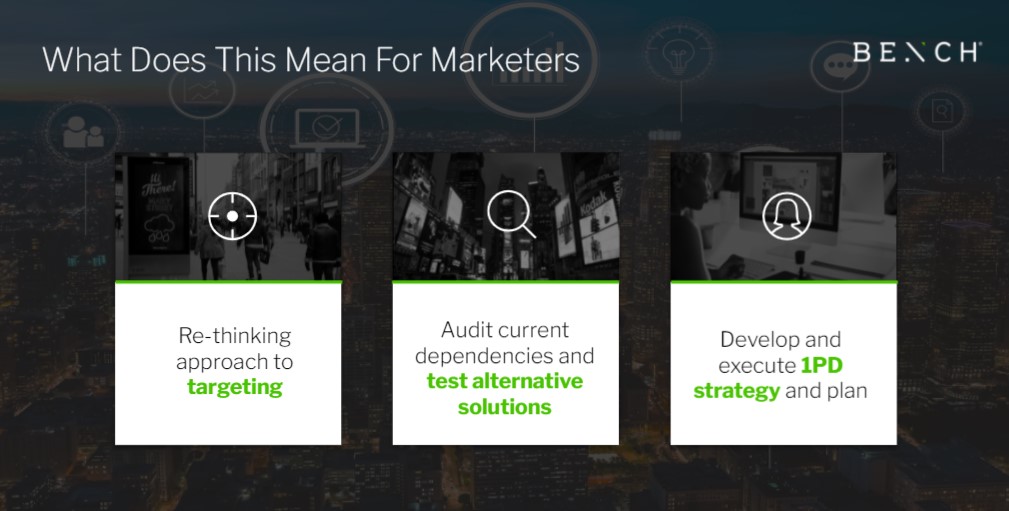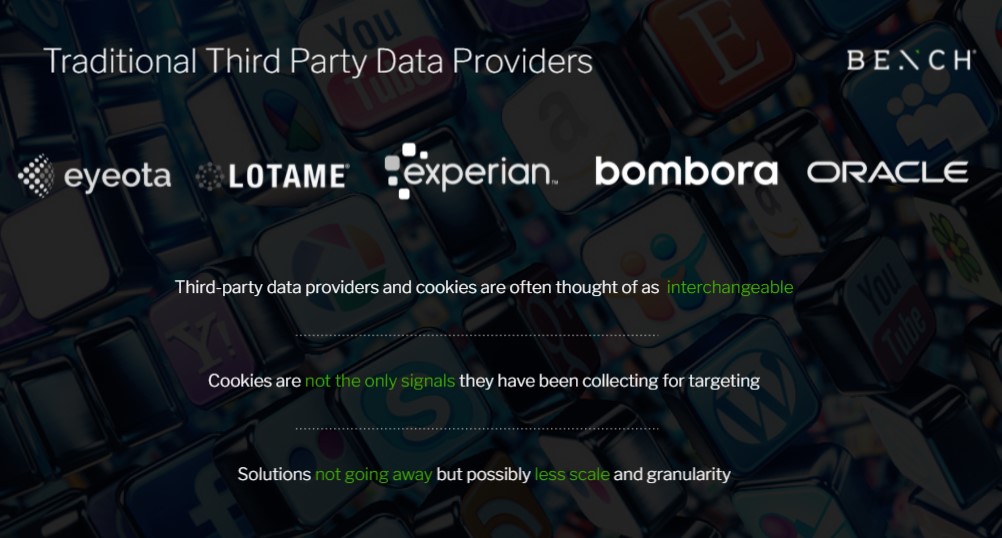Privacy regulation changes and digital disruption is set to have a significant impact on businesses and brands. Amongst all this ‘noise’, marketers want to know how these changes will impact digital advertising, and how it will affect the way they deliver campaigns at scale.
In order to adapt and thrive, marketers need to shift their mindset. They need to be honest with themselves and agree that once upon a time, cookies were the ‘easy’ option. Marketers need to embrace the change and see the absence of cookies as an opportunity.
During a recent virtual workshop hosted by Bench, The Future of Targeting, leading industry professionals shared their perspectives on the future of digital advertising. In the workshop, they evaluated everything with a fresh lens, by focusing on the new and innovative opportunities of a cookieless-future for marketers.
The expert panel included:
- Esther Carlsen, General Manager at Bench;
- Sam Thompson, Head of Media and Partnerships at Bench;
- Ryan Sullivan, Senior Partnerships Manager at Bench; and
- Jessica Miles, Country Manager at Integral Ad Science (IAS).
The panel discussed how the changes to third party cookies would impact marketers, sharing practical examples of what marketers can do now and unpacking what continues to be possible when it comes to effective consumer targeting.
Unpacking the cookieless-future: key impacts
While there are seismic industry shifts, marketers need to see these changes as opportunities. As a consumer-led industry, businesses should actively encourage solutions that provide cross-media and cross-platform strategies with consumer privacy at the core.
There are three key impacts marketers and organisations will experience by the removal of third-party cookies, according to Ryan Sullivan, Senior Partnerships Manager at Bench:
- Customer targeting: Without cookies, there are fewer identifiers for tracking consumers. While cookies weren’t a perfect solution, they did track customers at scale and with granularity.
- Testing: To ensure the right customers are targeted. Organisations will have to rethink their cookie-led approach in finding prospective customers.
- Data collection: Marketers will have to be savvier in their data collection and how they access other providers’ first-party data sources. This is going to increase in importance as we move forward.

Unlocking first-party data
Publisher first-party data
Publisher first-party data is going to be key in the future. Brands like Spotify, SBS, Kayo and News Corp are legacy organisations that won’t be disappearing anytime soon. According to Sullivan, these publishers have been investing a lot of money in developing their own data collection strategies in the last few years.
Visitors are being asked more frequently to log into the media platforms to access gated content,” Sullivan says. “The explosion of Broadcaster Video-on-Demand (BVOD) has only accelerated that. This is really for the purpose of the publisher’s data collection. They want to know who you are. They want to know the content you’re interested in, your location and your demographics.
“On top of that, publishers are working with other data partners, like Ticketek and Red Planet. This helps them scale and enrich their own data offering.”
The premium data is only going to get better as it is first-party logged and verified user information, Sullivan explains. Couple this with premium quality content written by network journalists on premium publisher sites, and users will be willing to pay more for this quality content.
Sullivan highlights that premium quality means it gets priced accordingly. But when you’re buying this access to these publishers in a silo, there is a lack of scale.
“Let’s say you want to try and combat that scale and buy across multiple publishers. What ends up happening is, it becomes an inefficiency in the workflow,” Sullivan explains. “This buying, it’s not new, it takes us back to the direct media buy date. In a programmatic world, this is your PMP, your private marketplace deals. The question would be, why would you not just buy direct with these guys?”
The main reason is, when you’re buying programmatically across all of these publishers, what it allows you to do is optimise across them all, as well as frequency cap across your entire campaign.
Platforms with first-party data
Marketers can help scale their executions by activating across platforms that have their own first-party data. This includes platforms like Google, Verizon, Amobee, Amazon and Facebook.
Similar to publishers, these platforms package up their first-party data and the media that can be accessed by visitors.
Sam Thompson, Head of Media and Partnerships at Bench, explains marketers can use this first-party data for marketing purposes to plan and buy their campaigns.
“The one consistent thing I find in these platforms is they will build to offer a consumer service. They were not primarily developed as a media buying solution,” Thompson says. “Therefore you’ve got this known value exchange between the consumer and that service, which really allows them to scale out their rich data collection strategies.”
According to Thompson, there are some valuable considerations that marketers should note in using these platforms. First, the accuracy of data. The data is accurate to the point of an email address which is being used to sign in on the platform. The sheer volume of people that use these platforms allows marketers to get scalable data.
Secondly, it’s cost-efficient to buy. The data usually comes free with the platform when activating a targeted campaign. Thompson suggests organisations pay attention as the data is siloed to the platforms they are activating in.
This effectively creates what is affectionately known as the walled gardens. For example, a marketer is unable to use Amazon’s data on YouTube. They put the walls up and you’ve got to play within those walls,” Thompson adds.
Thompson breaks down how and where platforms such as Google, Verizon, Amazon, Facebook and Amobee get their data.
Google collects their data from services such as Gmail, Search and Maps. That data is generally highly targeted interest and intent-based data.
Similarly, the majority of Verizon’s data comes from Yahoo Mail, as well as website data from their owned and operated network of publishers such as Yahoo Finance. Verizon also has location and content data through their network carrier data and purchase data as well.
Thompson says, “What I like about Verizon is it’s looking through a completely different lens to Google. While it’s still good for that highly targeted interest and intent-based data, it’s across a completely different environment to those Google users.
“You might use it for the same types of reasons as you would use Google data, but across a completely different audience base and different environment as well.”
Amazon, on the other hand, collects their data from a range of different sources such as Amazon Marketplace, Prime Video, Audible, Twitch and IMDb. These broad data sources have allowed Amazon to truly scale highly targeted product data, purchase data, demographic data, and both consumer and product life stage data. No wonder Amazon is fast scaling the Australian Market.
“There’s so much purchasing intent data available there,” Thompson says. “You may think it should be used for ecommerce driven strategies, which it can. But keep in mind it’s also great to use for a whole bunch of other different reasons such as life stage campaigns, demo based campaigns, and both brand and performance.”
Contrastingly, Facebook collects their data from the Facebook platform, and their other owned social media platforms Instagram and Facebook Messenger. Their data is predominantly social, and is based on social interactions. However it lends nicely into hyper-targeted locational data, as well as scalable demographic and interest-based datasets.
Amobee also has a strong scalable asset. Partnering with Optus data locally and throughout Southeast Asia with a single data network has allowed Amobee to scale highly targeted telco data campaigns, demographic data and financial data. All these datasets can be used for a range of different types of campaigns.
Thompsons reveals if organisations are working with one of these platforms, they can leverage their unique value and data. However, they will be limited to what they can access within the platform.
The real value of this comes from an agnostic approach, which allows marketers to do two things,” he says. “First, it allows companies to plan campaigns using the best platform. Based on what that organisation is trying to achieve, the marketer can choose the platform, or combination of platforms, and the associated data assets required.”
“Secondly, it allows marketers to test, learn and optimise between platforms to drive the most success for business outcomes.
Using traditional third-party providers
Most organisations have had experience with third-party data providers in the past. These brands include Iota, Experian, Lotame and Oracle.
The overall assumption is third-party equals cookie, and these providers will eventually wither away because of their association with cookie consumer targeting. However, that’s unlikely to be the case. Third-party providers have been planning and preparing for this particular cookie-free scenario for some time.
Sullivan explains while it is fair to say the majority of their scale came from cookies, that’s not the only thing third-party providers have been collecting.
“For a while, they’ve been collecting the actual segment systems, which have been created with cookies,” Sullivan says. “They have also collected mobile ad IDs, first-party cookies, emails, contextual information, research data, survey data, and much more.”
“What that means for marketers and media planners is your standard off-the-shelf interest intent segments will all still be available in some form. They just won’t be based on cookie data.”
However, there’s a trade-off. The segments will probably have less scale, but they’ll likely increase in accuracy.
Moving forward, organisations should be testing these third-party segments alongside the first-party publisher strategies and first-party platform strategies,” Sullivan adds.

Part 2 of the workshop will be posted next week.
Bench Media’s virtual workshop, The Future of Targeting, is available on demand here.
Contact Bench to discuss privacy and cookieless targeting for your brand.





